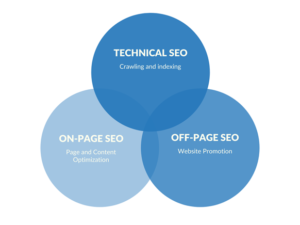Boost Your Website’s Performance and Visibility
Search engine optimization (SEO) is a key part of any digital marketing strategy, and understanding the nuances between on-site and off-site SEO techniques can be critical to driving success online.
While both types of SEO are valuable, technical SEO – which focuses on optimizing website infrastructure, such as page speed, server response times, and mobile friendliness – presents an additional layer of complexity and extensive opportunities for marketers to drive further success with their websites.
In this blog post, we’ll look at what Technical SEO is in more detail; explore its purpose for businesses in 2023 and discuss how marketers can make it work for them in executing successful digital strategies today.
What is Technical SEO
Technical SEO is a branch of Search Engine Optimization (SEO) that focuses on optimizing the technical aspects of a website to enable it to be more visible and accessible in search engine results pages.
It deals with site architecture, server configuration, page speed optimization, metadata, website structure, and other elements.
Technical SEO is essential for any business that wants to be visible on the web. Optimizing these technical aspects of a website can help increase traffic from organic search engine results pages (SERPs) and boost your visibility online.
The Importance of Technical SEO

The importance of Technical SEO cannot be understated. By optimizing the technical aspects of your website, you will be able to ensure that search engine bots can crawl and index your content (crawlability) quickly and accurately.
This process is essential for improving your ranking in SERPs and ensuring all users can easily access your site.
Components of Technical SEO
Technical SEO consists of several components to consider when optimizing a website. These include:
Site Architecture
This refers to the structure of your website and how it is organized. It should be designed so that bots can easily crawl and index all content and users can easily find the information they seek.
Server Configuration
This involves ensuring your server is configured correctly and can handle your website’s traffic. By optimizing your server, you can help ensure that pages load quickly and without any errors.
Page Speed Optimization
The speed at which pages load has a huge impact on user experience. Pages that take too long to load can result in users leaving your website, so optimizing the speed of your website’s pages is important.
Metadata
This includes titles and descriptions you create for each page on your website. The metadata should be keyword-rich and accurately describe the content of each page.
Website Structure
Your website’s structure should be designed to make it easy for users to navigate and find what they want. This includes adding breadcrumbs, creating clear hierarchies, and using anchor text for internal linking.
By optimizing these technical aspects of your website, you can ensure that search engine bots can crawl and index your content correctly, helping improve your visibility in SERPs.
Technical SEO vs. On-Page SEO vs. Off-Page SEO

Technical SEO, On-Page SEO, and Off-Page SEO all have different focuses but are ultimately connected in the overall process of Search Engine Optimization.
Technical SEO
Technical SEO or technical optimization is focused on optimizing the technical aspects of a website, such as its architecture, server configuration, page speed optimization, metadata, and structure.
On-Page SEO
On-Page SEO includes optimizing a website’s content, including titles, descriptions, and keywords. We will cover On-Page Seo in a separate article.
Off-Page SEO
Off-Page SEO includes activities such as keyword research and link building to help improve your ranking in SERPs.
By taking care of all three aspects of SEO, you can ensure that your website is visible and accessible to both search engine bots and users.
Overall, Technical SEO is an important part of any website’s SEO strategy. By taking care of the technical aspects of your website, you can ensure that search engine bots can crawl and index your content quickly and accurately. This will help improve your visibility online and increase traffic from organic search engine results pages. We will cover Off-Page Seo in a separate article.
Understanding Crawling (Crawlability)
When search engine bots crawl a website, they search for pages to index and add to their database. This process is essential for improving your ranking in SERPs and ensuring users can find the content they are searching for.
These bots look at various technical aspects of your website, such as the architecture, server configuration, page speed optimization, and metadata. They also look for any external links that may lead them to other websites or content related to their own.
By optimizing these technical aspects of your website, you can ensure that search engine bots crawl your site more quickly and accurately, resulting in better visibility for your content online.
You must first ensure that search engines can access your pages if you want them to appear in search results.
There are some ways to do this:
Create SEO-Friendly Site Architecture
Creating an SEO-friendly site architecture is crucial for optimizing your website’s visibility and search engine rankings. An effective site architecture involves organizing and structuring your web pages so search engines can easily crawl and understand the content.
Start by establishing a clear hierarchy, with a homepage leading to relevant categories and subcategories. Use descriptive and keyword-rich URLs and internal linking to enhance the navigation and establish page connections.
Implement a logical and intuitive navigation menu to help users and search engines find important content. By prioritizing user experience and optimizing your site structure, you can improve organic traffic, engagement, and, ultimately, the success of your website.
Submit Your Sitemap to Google
Creating and submitting a sitemap to Google is one of the most important steps in any SEO strategy. A sitemap will help search engine bots crawl your website more efficiently and accurately, ensuring all pages are indexed correctly.
You can use online tools such as XML-Sitemaps or Screaming Frog to generate your sitemap. Once you have created the sitemap, please submit it to Google Search Console.
Analyze Website Performance
Monitoring your website’s performance and analyzing data from analytics tools can help you identify any technical issues hindering its optimization. This includes checking page speed, server response time, and crawl errors reported in Google Search Console.
By regularly analyzing your website’s performance, you can ensure that all technical aspects are optimized and improve its visibility in SERPs.
Technical SEO Best Practices

When optimizing your website for search engines, following SEO best practices is important. These include:
Use HTTPS
HTTPS (Hypertext Transfer Protocol Secure) is an encrypted connection between a web server and a client’s browser. It ensures that data sent between the two remains private and secure. This type of encryption has become increasingly important due to the rise in cybercrime.
Google recommends using HTTPS on all websites for optimal security and improved search engine rankings. HTTPS URLs are also displayed as “secure” in browsers, which can improve user trust and engagement.
Implementing HTTPS is an important step for any website looking to optimize its technical SEO.
Improve Your Page Speed
Improving page speed is essential for optimizing technical SEO. Slow-loading pages frustrate users and cause search engine bots to take longer to crawl and index your content. This can negatively affect your visibility online.
To optimize page speed, start by compressing images and minifying code. Additionally, enable caching for static content and leverage browser caching. You can also consider reducing redirects, optimizing your server configuration, and using a content delivery network (CDN). Finally, use tools like PageSpeed Insights to analyze your website performance and identify any issues slowing down page speed.
Implement Structured Data
Structured data is an essential part of any website’s technical SEO strategy. Structured data helps search engine bots better parse and understand the content on your web pages, which can improve visibility in SERPs.
Structured data also allows for rich snippets to appear alongside your organic search results, which can increase click-through rates and boost engagement. Some popular forms of structured data include schema.org, JSON-LD, and Microdata.
When implementing structured data, include all relevant information about your web page and ensure it is correctly formatted to be interpreted by search engine bots.
Use an SEO Audit Tool to Find Duplicate Content
Duplicate content can cause search engine bots to crawl and index your pages more slowly, affecting visibility. Checking for duplicate content across your website is important to avoid this issue.
Using a Technical SEO Audit tool such as Ahrefs or SEMrush, you can analyze the content on your website and identify any instances of duplicate content. Once you have identified any duplicates, you can delete or redirect them to the correct page.
These are just some of the most important technical SEO best practices for optimizing visibility online and improving your website performance. By following these steps, you will be well on your way to achieving better rankings in search engine results pages and improved organic traffic.
Main Factors of Technical SEO

The main factors of technical SEO are:
Site Structure
Establishing a clear hierarchy and navigation structure for your website is essential to improve organic traffic. This includes setting up relevant categories, subcategories, and keyword-rich URLs. Optimizing internal linking will also help search engine bots crawl and index content more efficiently.
Page Speed
When optimizing for technical SEO, page speed should be a priority. Pages that load quickly and efficiently provide a better user experience and are more likely to rank higher in search engine results pages (SERPs). To improve page speed, consider compressing images, minifying code, enabling caching for static content, and leveraging browser caching. More Info…
Site Speed
Technical SEO refers to the loading speed of your website. A fast-loading site enhances user experience and can positively impact search engine rankings.
Internal Link Structure
Involves creating a network of internal links between your website’s pages. This helps search engines discover and crawl your content more effectively and establish the hierarchy and relevance of your pages.
Sitemap
A file that lists all the pages on your website, helping search engines understand the structure and organization of your content. It ensures that search engines can easily index and navigate your site.
Schema
Markup language (often in the form of Schema.org) is used to provide structured data to search engines. Adding schema markup to your content can enhance its visibility in search engine results pages and enable rich snippets. More info…
Snippets
The brief descriptions that appear below the title in search engine results. Optimizing snippets with relevant keywords and compelling content can increase click-through rates and drive more traffic to your website.
Canonicalization
A method to resolve duplicate content issues by specifying the preferred version of a web page. Canonical tags help search engines understand which version of a page should be indexed and ranked, avoiding potential penalties for duplicate content.
These are the main factors to consider when optimizing a website for technical SEO. By implementing these best practices, you can improve visibility in SERPs and drive more organic traffic to your website.
FAQs
What are some common Technical SEO issues?
Common Technical SEO issues include missing or duplicate pages, broken links, slow page loading times, incorrect website structure (such as excessive use of internal link redirects), and issues with the robots.txt file or XML sitemap.
Why is Technical SEO Important?
Technical SEO is important because it ensures that search engines can efficiently crawl and understand the content on a website, helping to improve visibility in SERPs. By implementing technical best practices, you can ensure your website ranks higher organically and drives more traffic.
What are some common Technical SEO best practices?
Some common Technical SEO best practices include using a sitemap to structure your website, optimizing page loading times, using redirects appropriately, using secure (HTTPS) connections on pages that collect user data and payment information, and ensuring multiple pages are accessible by search engine crawlers.
Conclusion
Overall, Technical SEO presents a challenge to webmasters seeking to improve their rankings, but with the right knowledge and best practices, you can develop an effective technical SEO strategy for your website. When done correctly, crafting a successful technical SEO campaign can help make sure your content is found, indexed, and ranked in search engine result pages (SERPS), ultimately reaching your target market more quickly and effectively. So why not take the plunge and get started today? The potential rewards are great, and if implemented correctly, Technical SEO could be the push you need to exceed your online goals!








